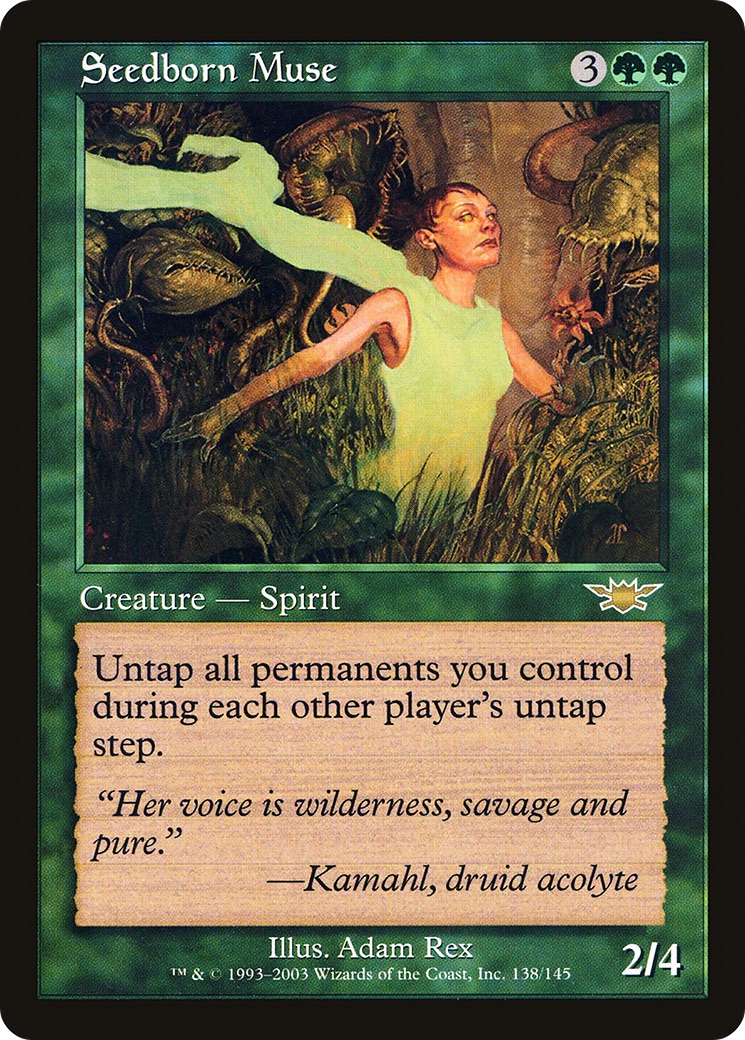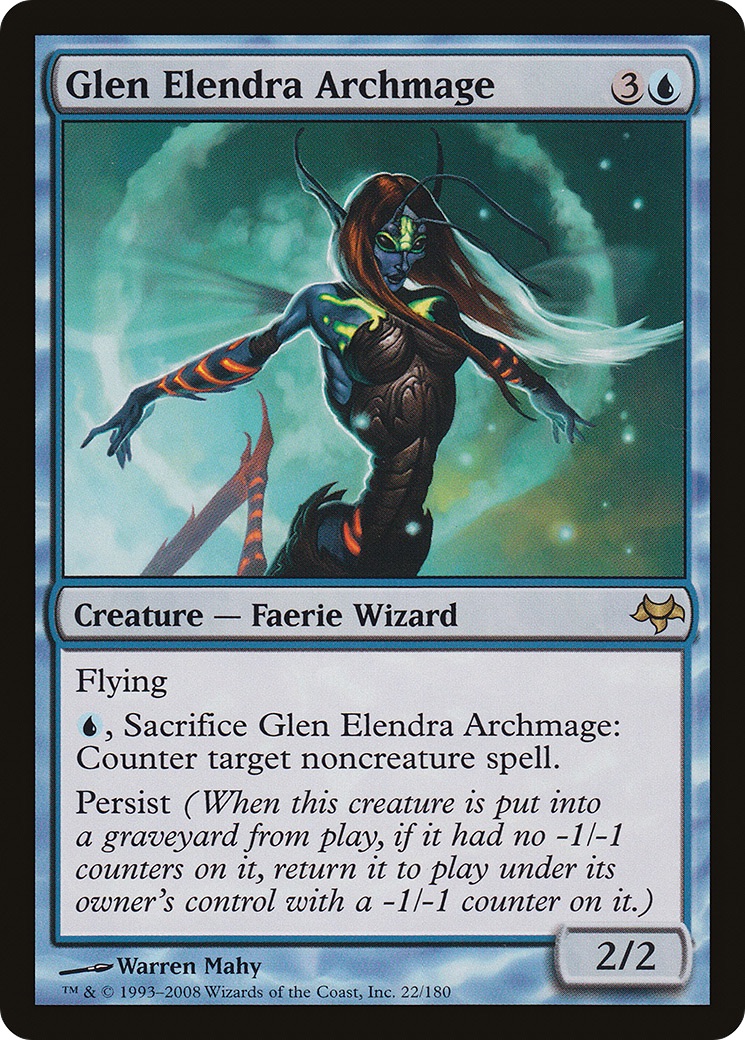My preferred cEDH deck at the moment is still Rograkh, Son of Rohgahh—Thrasios, Triton Hero, basically as written about here. After playing it a lot, I’ve come to what I imagine to be a fairly controversial conclusion: I don’t think I want to play Seedborn Muse.
The reason I expect this to be controversial is that almost every Thrasios deck in the cEDH database plays Seedborn Muse unless there’s some obvious reason not to, like Polymorph. I don’t have such a reason, in fact, I think Seedborn Muse is relatively good in my deck.

Rograkh helps make more mana to activate Thrasios more. In some decks, Thrasios plays a support role or serves as a backup plan, but in this deck, Rograkh is there to support Thrasios. Activating Thrasios is a core part of the game plan, and Seedborn Muse makes activating Thrasios much better. In fact, Seedborn Muse makes activating Thrasios so much better that an unanswered Seedborn Muse is pretty close to a win if you manage to get around the table roughly once.
So why wouldn’t I want that?
Answer-Checking the Table
The issue is that an unanswered Seedborn Muse is pretty close to a win, and everyone knows that. If I cast Seedborn Muse, someone’s going to answer it if they can. That means Seedborn Muse just answer-checks the table.
If no one has one, I’m in great shape; but most of the time, someone has an answer. Paying five mana to make a random player discard a random removal spell or counterspell is horrible, so realistically, I only want to play Seedborn Muse if I can protect it, but once I commit to going down that path, I’m trading my counters one for one with the table’s removal and counters.
If the table has more answers than I have, I’ve blown my hand and accomplished basically nothing. If the table has just enough answers, now I’m threatening to win if given a few turns and everyone knows all the answers were just used, so everyone does their best to win on their turn. This means that even winning the fight over Seedborn can cause me to lose by clearing the way for an actual win instead of a dominant engine.
Attempting to cast Seedborn Muse is structurally analogous to going for a win, but a bit less effective. It has the advantage that it’s a single card rather than a combo, but it’s a big enough mana investment that having it answered is a really bad exchange for me.
Five Mana Spells Should Win the Game
Five-plus mana spells that don’t win the game are problematic in cEDH—they either just pull a random answer from the table (horrible for you, bad for the one person who answered you, quite good for the other two players) or they stick and generally make everyone attack you (either with creatures or just spending their resources).
I think the appeal of Seedborn Muse is that it answers questions like, “How can I proactively use this Eldritch Evolution when I don’t have a combo win set up?” But I don’t think you need to have an answer to that question—I’m pretty happy to answer, “I don’t. I activate Thrasios instead.”
Your Cards Should Fit Your Play Style
I think a lot of this comes down to play style. In general, I think it’s really important in cEDH to build your deck to play precisely the game you want to play. The game is so much more about how you play the table and when you take your actions and so much less about how efficiently your deck can goldfish. In cEDH, you really just want cards that play to exactly what you want to be doing.
I know that what I want to do is sit back and protect myself as strictly required but mostly allow players to become threatening, develop a hand, and go for a protected win when I think I can resolve it. Seedborn Muse is just too big of an investment for my strategy.
I think Seedborn Muse is great if your plan is generally to jam your threats and check the table. Sometimes people don’t have it!
The problem for me is that I’m going to play it cautiously most of the time, and it’s a horrible card to have sitting in your hand since it can’t be used reactively. If you cast it at the first opportunity, it’ll win you some portion of those games, and it’ll probably win a higher portion of those games than other cards you could play with a similar purpose. I just don’t think cards with that purpose fit my game plan.

What Card Should Replace Seedborn Muse?
The question of what to replace it with isn’t very interesting, especially given that I know I’m not looking for a similar card. I just free up a space in my deck and play whatever I think the next best card I wasn’t playing before was.
However, I did consider one creature that could serve a slightly analogous role: Glen Elendra Archmage. The thing that’s similar about Archmage is that it’s an impactful creature you can play proactively. The reason it’s better Seedborn Muse for me is that anyone who thinks it’s likely that they can wait out the other players won see Glen Elendra Archmage. as a threat and might be reasonably happy, or at least content, to let it resolve. It also lines up a lot better against removal than Seedborn Muse.
Unfortunately, it doesn’t similarly advance your game plan. Every turn that passes, Seedborn Muse brings you much closer to winning, while Glen Elendra doesn’t do anything. But Glen Elendra does make it much harder for other players to try to win and much easier for you to try to win.
They are very different cards, but for my purposes, I think I prefer Glen Elendra. I’m currently not playing it, but I think that might be a mistake, especially since I’m playing Phyrexian Metamorph and Machine God’s Effigy and both are incredible with Glen Elendra Archmage because you can copy the Archmage. Then, when the artifacts persist, they can copy something else. I’m going to keep considering it, but I’m starting with a half measure and trying the much cheaper Malevolent Hermit. I don’t know which I prefer.
Avoiding the Seedborn Muse Trap
Incidentally, I think of Biomancer’s Familiar somewhat similarly to Seedborn Muse—they’re both non-combo creatures that generate value by making Thrasios better. Both are threatening enough that I’m not surprised if someone kills them, but I think Biomancer’s Familiar has a much better chance of survival and it’s much less bad for me if it gets killed since it only costs two mana (instead of five). I’m very happy with the profit to mana to threat level ratio of Biomancer’s Familiar and would love more cards like that, but the ratio for Seedborn Muse just isn’t at a point that I’m comfortable with.
This is also in line with my general experience of tuning decks for cEDH, which is that I basically just always lower the curves of all my decks over time (which is why I suspect Hermit over Archmage is just skipping a step).
These aren’t relevant for my deck, but there are some other creatures I’ve been thinking about that are in a somewhat similar space in terms of being relatively expensive, but generically good to have in play and generically threatening, but that I think fall into a slightly better space. Namely Sheoldred, the Apocalypse and Talion, the Kindly Lord.
Sheoldred gives you a meaningful life buffer pretty quickly and meaningfully pressures the table. It doesn’t exactly threaten a win and a lot of people can safely ignore it for a while, but it disables some plays and sometimes makes games come down to life totals (at least for some players). This is another card like Glen Elendra Archmage that benefits from the fact that some players might not find it particularly problematic for them. If someone else has a Mystic Remora or The One Ring, other players might appreciate that there’s something pressuring their life total. They probably protect your Sheoldred, but they certainly won’t kill it.
I’ve talked about how I generally want to play the second most threatening thing in EDH so that my thing isn’t the thing absorbing a removal spell. In cEDH I think it’s a little less about what happens to be the most threatening thing at any given moment and more about whether something passes the “most answer” threshold. I like cards that sit just below it—I think against identical opposing hands, Sheoldred survives a lot more often than Seedborn Muse.
I have less experience with Talion in play. Specifically, I’ve played against it exactly once, and it was immediately Phyrexian Metamorph’d by another player. It generated some value before I decided I had to deal with it. I think Talion’s in a great place—slightly less threatening than Seedborn Muse, but with a payoff that benefits you more relevantly than Sheoldred (since it draws cards), and if you have a good idea of how it will be answered, you can choose a number such that someone might have to give you a card to answer it. I think Talion’s great in most decks that can cast it.
To recap/reiterate, yes, I’m suggesting that “this card is too powerful” is a strike against Seedborn Muse and that the same thing but not as good might be better, but really, I just want things that cost a little bit less mana for a little bit less impact.
I want to be very clear that this isn’t a “dies to Doom Blade” argument—this is how multiplayer is different than one-on-one. In a one-on-one game, your opponent’s removal was going to trade with one of your cards anyway, so you might as well play something that’s very punishing when they don’t have it. In multiplayer, a card that demands an answer will get one, and you’ll have traded with the table, but a card that does something good but doesn’t demand an answer might get to stay around and do something while the answer trades with someone else at the table, which is fantastic for you.
Ultimately, the jury’s still out for me on how I feel about threatening but productive four-mana creatures. I know I’m happy with them at two mana and unhappy with them at five mana. The answer likely depends on the deck, and for other players, it should also depend on how you plan on playing the game.
Sam Black (any) is a former professional Magic player, longtime Magic writer, host of the Drafting Archetypes podcast, and Twitch streamer. Sam is also a Commander Cube enthusiast, and you can find Sam’s cube list here. For anything else, find Sam on Twitter: @SamuelHBlack.

